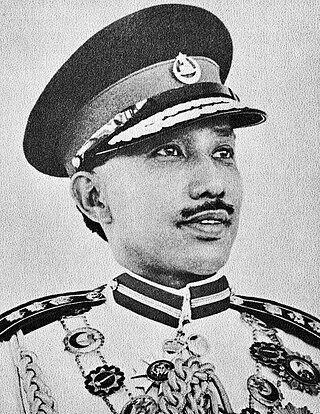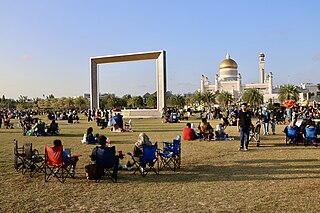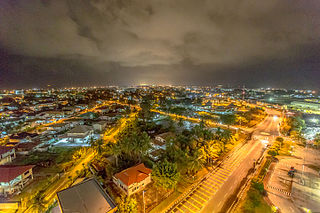
Bandar Seri Begawan (BSB) is the capital and largest city of Brunei. It is officially a municipal area with an area of 100.36 square kilometres (38.75 sq mi) and an estimated population of 100,700 as of 2007. It is part of Brunei–Muara District, the smallest yet most populous district which is home to over 70 per cent of the country's population. It is the country's largest urban centre and nominally the country's only city. The capital is home to Brunei's seat of government, as well as a commercial and cultural centre. It was formerly known as Brunei Town until it was renamed in 1970 in honour of Omar Ali Saifuddien III, the 28th Sultan of Brunei and the father of Sultan Hassanal Bolkiah.

Omar Ali Saifuddien Sa'adul Khairi Waddien was the 28th Sultan of Brunei, reigning from 1950 until his abdication in 1967 to his oldest son, Hassanal Bolkiah.

Belait District or simply known as Belait, is the largest as well as the westernmost district in Brunei. It has an area of 2,727 square kilometres (1,053 sq mi) and the population of 65,531 as of 2021. The administrative town is Kuala Belait, located at the mouth of the 32 kilometres (20 mi) long Belait River. The district is commonly associated with the oil and gas industry of the country, mainly concentrated near the town of Seria.

Brunei–Muara District or simply known as Brunei–Muara, is the smallest as well as the most populated district in Brunei. It has an area of 571 square kilometres (220 sq mi) and the population of 318,530 as of 2021. The district is also home to its administrative centre is Bandar Seri Begawan, as well as the Brunei International Airport and Muara Port, the country's only international airport and deep-water port respectively. The Brunei River flows within this district and is home to Kampong Ayer. As the administrative center of Brunei is located in the district, it remains the most developed in the country with the most up-to-date infrastructure, despite not being the center of Brunei's main economic activity.

Muhammad Jamalul Alam II was the 26th Sultan of Brunei from 1906 until his death in 1924. He was succeeded by his eldest son Sultan Ahmad Tajuddin.

Kuala Belait or officially the Kuala Belait Town, and colloquially referred to as KB, is the administrative town of Belait District, Brunei. The population of the town proper was 4,259 in 2016. Kuala Belait is officially a municipal area, as well as a village under the mukim of the same name. The town is located 85 kilometres (53 mi) west of the country's capital Bandar Seri Begawan, and 20 kilometres (12 mi) west of Seria, the district's other town. It is also in the westernmost part of country, near the mouth of the Belait River.

Seria or officially known as Seria Town, is a town in Belait District, Brunei. It is located about 65 kilometres (40 mi) west from the country's capital Bandar Seri Begawan. The total population was 3,625 in 2016. It was where oil was first struck in Brunei in 1929 and has since become a centre for the country's oil and gas industry. The town's bazaar, officially opened on 19 September 1954, has few retail establishments, fresh food markets, supermarkets, banking services, tourist information centers, and a range of restaurants, including Malay, Chinese, Indian, Indonesian and Italian ones as well as outdoor dining in somewhat rustic settings. For processing documentation related to owning a car and hiring domestic helpers (amahs), government offices are located in Kuala Belait.

Muara or officially known as Muara Town, is a port town in Brunei-Muara District, Brunei, about 28 kilometres (17 mi) from the capital Bandar Seri Begawan. The population of the town proper was 2,102 in 2016. It is home to Muara Port, the country's primary deep water port.
The administrative divisions of Brunei Darussalam mainly consist of daerah (districts), mukim (sub-districts), and kampung or kampong (villages). They are organised hierarchically in Brunei Darussalam, with daerah being the largest first level, and kampong the smallest third level.

Kampong Pengkalan Gadong or commonly known as Gadong, is a village in Brunei–Muara District, Brunei, as well as a neighbourhood and commercial area in the capital Bandar Seri Begawan. The population was 3,147 in 2016. It is one the villages within Mukim Gadong 'B'. The postcode is BE3719. It is a popular shopping and dining area in the city as well as in Brunei, with several shops, restaurants and cafes establishing their presence in the area. Notably, the area was formerly a rubber estate and was called Gadong Estate or Gadong Rubber Estate.

Pusat Bandar is the city centre of Bandar Seri Begawan, the capital of Brunei. It is home to a number of national landmarks, important government offices, and commercial and financial establishments.

Transport in Brunei consists of air, land, and sea transport. Previously there was some rail transport in Brunei, but eventually most of it was closed down. Several public and commercial sector organizations are in charge of creating and overseeing these networks and infrastructures. The Ministry of Transport and Infocommunications (MTIC) is in charge of overseeing the maritime and aviation industries, as well as planning and regulating all kinds of land transportation.

Kampong Tungku is a village in Brunei-Muara District, Brunei, about 10 kilometres (6.2 mi) from the capital Bandar Seri Begawan. The population was 1,689 in 2016. It is one of the villages within Mukim Gadong 'A'. The postcode is BE2119.

The Kianggeh River is a small tributary of the Brunei that flows through Bandar Seri Begawan, the capital of Brunei.

Kampong Kumbang Pasang, or simply Kumbang Pasang, is a village within Mukim Kianggeh in Brunei-Muara District, Brunei. It is also part of the municipal area of the capital Bandar Seri Begawan. The population was 563 in 2016. It has the postcode BA1511. The village formerly hosts a rubber plantation and was named Kumbang Pasang Estate. Notably the village was once its own Mukim, known as Mukim Kumbang Pasang.

The Department of Energy, previously known as the Ministry of Energy and Ministry of Energy, Manpower and Industry, is a cabinet-level ministry in the Government of Brunei which oversees the country's energy industry. The department is led by the incumbent Deputy Minister of Energy, Mohammad Azmi bin Mohd Hanifah. The ministry is headquartered in the capital Bandar Seri Begawan, currently within the Prime Minister's Office building at Jalan Perdana Menteri.

The Ministry of Defence Brunei Darussalam, officially abbreviated as MinDef, is a cabinet-level ministry of the Government of Brunei. It is responsible for the national security and its military forces within the sultanate of Brunei Darussalam; the latter collectively known as the Royal Brunei Armed Forces (RBAF); Angkatan Bersenjata Diraja Brunei, (ABDB). MinDef is Brunei's ministry of defence; and was established on 1 January 1984, when Brunei Darussalam achieved independence from the United Kingdom. The Ministry of Defence leadership presently consists of a minister ; its incumbent is the Sultan of Brunei, Hassanal Bolkiah, who is also the Supreme Commander of the RBAF / ABDB. A deputy minister is second-in-command at the Ministry of Defence.

Kampong Melabau is a neighbourhood in Brunei–Muara District, Brunei, as well as the capital Bandar Seri Begawan. The population was 288 in 2016. It is one of the villages within Mukim Kianggeh. The postcode is BA2511.

The Kampong Ayer Cultural and Tourism Gallery is a museum in Kampong Ayer of Bandar Seri Begawan, Brunei. The gallery features exhibits on its handcrafted goods, including ceramics, woodworking, and weaving.

The Dermaga Diraja Bandar Seri Begawan, simply known as the Royal Wharf, is a 1.8 hectares waterfront site located in Bandar Seri Begawan. Originally known as the Royal Customs and Excise Wharf, it has a rich history as both a port and an entry point for passengers and imported goods arriving by sea. The significance of this wharf, along with the former customs building, lies in its role as a historic gateway to Brunei. This importance was further emphasised with major renovations completed in April 2011, solidifying its status as the primary port of entry for both passengers and cargo. During the early 1950s, trade between Brunei and other countries saw substantial growth, further highlighting the wharf’s crucial role in the nation’s economy.




















